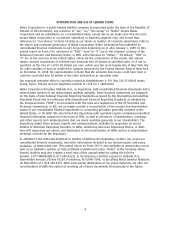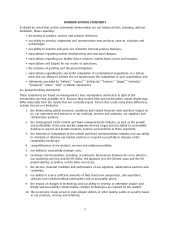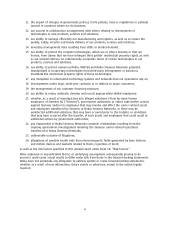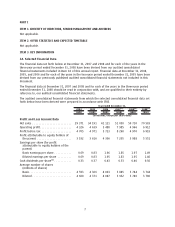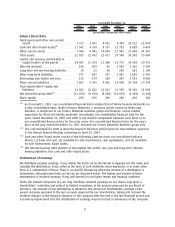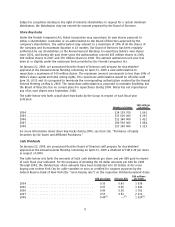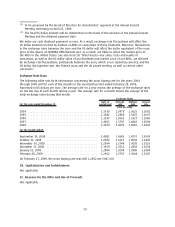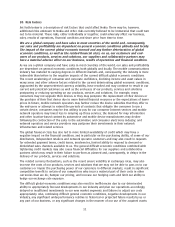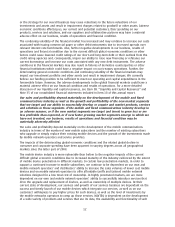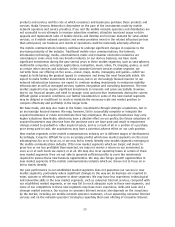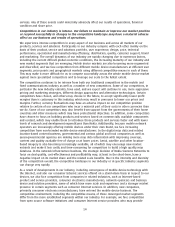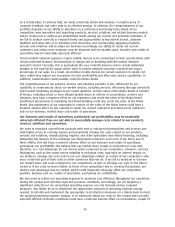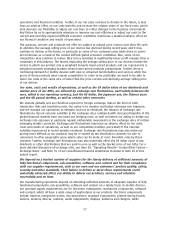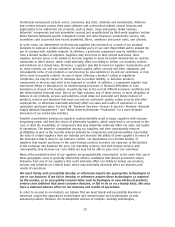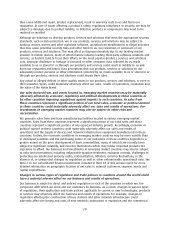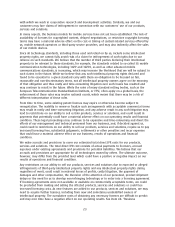Nokia 2008 Annual Report Download - page 15
Download and view the complete annual report
Please find page 15 of the 2008 Nokia annual report below. You can navigate through the pages in the report by either clicking on the pages listed below, or by using the keyword search tool below to find specific information within the annual report.services. Any of these events could materially adversely affect our results of operations, financial
condition and share price.
Competition in our industry is intense. Our failure to maintain or improve our market position
or respond successfully to changes in the competitive landscape may have a material adverse
effect on our business and results of operations.
We experience intense competition in every aspect of our business and across all markets of our
products, services and solutions. Participants in our industry compete with each other mainly on the
basis of their product, service and solutions portfolio, user experience, design, price, technical
performance, operational and manufacturing efficiency, distribution, quality, customer support, brand
and marketing. The overall dynamics of our industry are rapidly changing due to numerous factors,
including the current difficult global economic conditions, the increasing maturity of our industry and
new market segments that are emerging. Mobile device markets are also becoming more segmented
and diversified, and we face competition from different mobile device manufacturers at different user
segments, price points and geographical markets using different competitive means in each of them.
This may make it more difficult for us to compete successfully across the whole mobile device market
against more specialized competitors and to leverage our scale to the fullest extent.
The competition continues to be intense from both our traditional competitors in the mobile and
fixed communications industry as well as a number of new competitors. Some of our competitors, in
particular the new industry entrants, have used, and we expect will continue to use, more aggressive
pricing and marketing strategies, different design approaches and alternative technologies. Certain
competitors have chosen, and others may choose in the future, to accept significantly lower profit
margins than is customary in this industry, which may result in pressures to lower our prices and
margins. Further, currency fluctuations may have an adverse impact on our competitive position
relative to certain of our competitors who incur a material part of their costs in other currencies than
we do. Some of our competitors may also benefit from support from the governments of their home
countries and other measures which may have protectionist objectives. In addition, some competitors
have chosen to focus on building products and services based on commercially available components
and content, which may enable them to introduce those products and services faster and with lower
levels of research and development expenditures than Nokia. Additionally, because mobile network
operators are increasingly offering mobile devices under their own brand, we face increasing
competition from nonbranded mobile device manufacturers. In the digital map data and related
locationbased content business, governmental and various global and local companies as well as
quasigovernmental agencies are making more map data information with improving coverage,
content and quality available free of charge or at lower prices. Aerial, satellite and other location
based imagery is also becoming increasingly available, all of which may encourage new market
entrants and make it less costly and timeconsuming for competitors to build a high quality map
database. In the network infrastructure business, the strategic decision of Nokia Siemens Networks to
focus on deal quality, costeffectiveness and profitability may, at least in the shortterm, have a
negative impact on its market share and the related scale benefits. Due to the intensity and diversity
of the competition overall, the competitive landscape in our industry or in specific industry segments
can change very rapidly.
As a result of developments in our industry, including convergence of mobile device technology with
the Internet, and also our consumer Internet services offered on a standalone basis in respect to our
devices, we also face competition from companies in related industries, such as Internetbased
product and service providers, consumer electronics manufacturers, network operators and business
device and solution providers, some of which have more scale and experience and a stronger market
presence in certain segments such as consumer Internet services. In addition, new companies,
primarily consumer electronics manufacturers, have entered the mobile device business. The
competitive environment, including the competitive means, of these converged market segments
differ from the more established segments within our industry. For example, we face competition
from open source software initiatives and consumer Internet service providers who may provide
14


